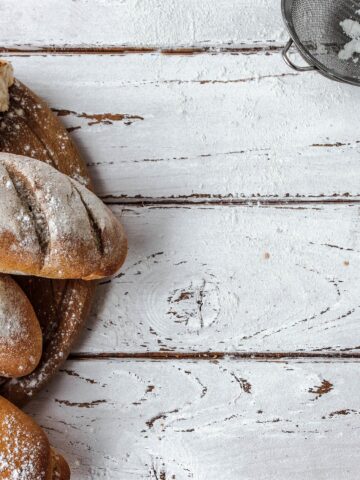The science of gluten-free baking can be hard to figure out. Keep reading for all my tips and tricks on how to make perfect gluten-free treats!

Baking science sounds complicated enough, but the science of gluten-free baking? Now that sounds confusing! Don't worry, I've got all the basics of gluten-free baking covered so you'll never be confused in the kitchen again.
In this post, I'll define what the science of gluten-free baking is, show some examples of why it's good to know the science of gluten-free baking and give you some recipes and tips on the science of gluten-free baking to get perfect gluten-free treats every time!
Jump to:
What is the science of gluten-free baking?
In traditional (non-gluten-free) baking, baking science is all about how the dough rises, why cookies spread, and what temperature is best for your oven. But the science of gluten-free baking is all that and MORE!
The most important parts of a gluten-free recipe are the oven temperature, gluten-free flour blend, and moisture levels.
Oven temperature is crucial for gluten-free recipes because gluten-free treats brown faster and bake slower than a non-gluten-free recipe. Gluten-free flour holds more moisture which makes the baked good take longer to bake through. Pay attention to baking time in recipes and adjust accordingly. For example, a gluten-filled cookie may be baked at 350 degrees for 12 minutes. Adjust the oven temperature to 325 degrees and bake the cookies for 18-20 minutes if making gluten-free cookies.
A gluten-free flour blend is best if it already contains xanthan gum. Not all gluten-free flours are the same blend of ingredients, so it's essential to check the label to see if the blend contains xanthan gum; however, some gluten-free recipes call for a flour blend WITHOUT xanthan gum. If the blend doesn't contain xanthan gum, the baked good may turn out dense and grainy instead of fluffy.
Moisture is key in gluten-free recipes. Gluten-free flour absorbs more liquid than regular flour, so you must account for that by adding more eggs, milk, and/or butter to recipes. The ingredients in gluten-free flour blends, like brown rice flour, tapioca starch, potato starches, or white rice flour, absorb a lot of moisture. To read some quick tips on gluten-free baking, click HERE.
Why is the science of gluten-free baking important?
It is SO important to understand the basics of gluten-free baking if you're gluten-free or know somebody who is gluten-free.
- Of course, you want a recipe to turn out, and knowing the science behind gluten-free baking makes it more likely that your gluten-free baked goods will turn out.
- If you're a baker, I think it's beneficial to know this information in case you need to ever make a gluten-free recipe like gluten-free bread. More and more people are turning to gluten-free foods, too. Knowledge is power!
- It's always good to know the differences between different blends of gluten-free flour. To read my full guide on gluten-free flour, click HERE.
Types of Gluten-Free Flours
- Almond Flour - almond flour is made from ground almonds. It has a slightly nutty flavor, but it is not a 1:1 substitute for a gluten-free flour blend.
- Oat Flour - oat flour is made from ground oats, so you need to make sure they are certified gluten-free. Oat flour makes cookies gooey, but I recommend using oat flour in combination with another gluten-free flour for most gluten-free batters and gluten-free goods.
- Gluten-free flour blend - a good gluten-free flour blend like King Arthur's Measure-for-Measure or Cup4Cup are both great for anyone on a gluten-free diet. It's a 1:1 substitute for regular flour (so 1 cup of flour to 1 cup of gluten-free flour).
Science Behind Common Baking Problems
Mushy Texture
The mushy texture in cookies, cakes, and quick breads usually comes from a problem with oven temperatures. I recommend lowering the oven temperature and baking the confection for a longer time.
Overcooked
If a baked good is overcooked, that means it's most likely in an oven that is too hot. It's similar to a mushy temperature. Lower the oven temperature and bake the treat for a longer time.
Too Dense
A dense final product means you need more baking powder or baking soda. Check to see if the recipe calls for it, and try adding a combination of baking powder and baking soda to give the treat a softer texture.
Dry Texture
A dry texture means you need more liquid. Try adding an extra egg, some buttermilk, yogurt, or butter to the batter for a moist baked good.
Crumbly
A crumbly final product means you need to add more xanthan gum. Double-check to make sure the flour blend you used contained it, too.
***
Gluten-free baked goods can be a tricky thing to figure out because it's an exact science, but you'll figure it out with these tips. To read more about my gluten-free baking school, click HERE.









Leave a Reply